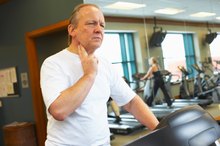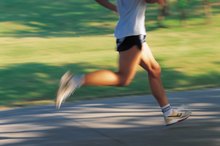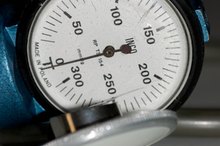How Long for Your Blood Pressure to Return to Normal After Running?
Running causes your heart to beat faster, which in turn causes your blood pressure to increase. This is due to the velocity at which the blood is expelled from the heart. The pace at which you run, in part, determines your blood pressure. A more intense running pace means a longer recovery period but, in general, your pace should return to normal fairly quickly after you stop running. Speak to your doctor if you feel that your blood pressure remains unusually high after running.
Blood Pressure
Your blood pressure constantly changes depending on what the body is doing. The force that is exerted onto the walls of the arteries creates a rhythmic pressure. This pressure is the result of the heart rate and the amount of blood expelled from the heart's chambers. If your body is active, the heart rate increases and more blood is pumped through the body, which increases blood pressure. According to MedlinePlus, the ideal blood pressure measurement for a healthy adult at rest is 120 mmHg--the systolic pressure--over 80 mmHg--the diastolic pressure. The abbreviation mmHG stands for millimeters of mercury.
- Your blood pressure constantly changes depending on what the body is doing.
- This pressure is the result of the heart rate and the amount of blood expelled from the heart's chambers.
Systolic and Diastolic
How Many Calories Do You Burn While Jogging 4.5 MPH?
Learn More
Blood pressure is measured in two readings and written as a ratio. The top number represents the systolic pressure, or the pressure in the arteries when the heart beats. The bottom number, which is typically the lower of the two numbers, measures the pressure between heartbeats. The heart refills with blood at this point before it contracts again. Running, or exercise in general, causes an increase in systolic pressure. The diastolic pressure remains relatively unchanged. Aerobic exercises tend to have less of an impact on blood pressure than anaerobic exercises, such as lifting weights. This is because the strain of strenuous anaerobic exercise requires the heart to contract harder. Blood pressure, in this sense, should not be confused with heart rate. A heart rate should increase when running but not necessarily when weight training.
- Blood pressure is measured in two readings and written as a ratio.
- Aerobic exercises tend to have less of an impact on blood pressure than anaerobic exercises, such as lifting weights.
Recovery
Your blood pressure, along with your heart rate, begins to lower once you stop running. While there is no standard recovery period, your blood pressure should return to normal within a few minutes. Your individual recovery period depends on the intensity and pace of your run, as well as your overall health. Healthier individuals tend to have faster recovery times, since their hearts are more accustomed to regular exercise. Their hearts do not have to work as hard to pump blood through the body as in people who rarely exercise or are beginners.
- Your blood pressure, along with your heart rate, begins to lower once you stop running.
Hypertension
How Does Blood Pressure Respond to Isometric Exercise?
Learn More
While it's considered perfectly normal to have elevated blood pressure while and shortly after running, high blood pressure once the heart rate has returned to normal and your body is otherwise at rest is cause for concern. If you feel your blood pressure is too high during rest, go see your doctor. He can help determine if you have hypertension, or high blood pressure. There are many causes for high blood pressure, but regular exercise can help you lower your resting blood pressure over time. MayoClinic.com notes that exercise helps strengthen the heart, which can pump more blood less effortlessly.
- While it's considered perfectly normal to have elevated blood pressure while and shortly after running, high blood pressure once the heart rate has returned to normal and your body is otherwise at rest is cause for concern.
- There are many causes for high blood pressure, but regular exercise can help you lower your resting blood pressure over time.
Related Articles
References
- American Heart Association; Understanding Blood Pressure Readings; May 2011
- MayoClinic.com; What's a normal resting heart rate?; Edward Laskowski; September 2010
- MayoClinic.com; Exercise: A drug-free approach to lowering high blood pressure; August 2010
- Siu AL. Screening for high blood pressure in adults: U.S. Preventive Services Task Force recommendation statement. Ann Intern Med. 2015;163(10):778-86. doi:10.7326/M15-2223
- American Heart Association. Understanding blood pressure readings. Last reviewed November 30, 2017
- National Institute on Aging. High blood pressure. Updated May 2, 2018
- Rockwood MR, Howlett SE. Blood pressure in relation to age and frailty. Can Geriatr J. 2011;14(1):2-7. doi:10.5770/cgj.v14i1.1
- AgePage: High Blood Pressure. National Institute on Aging.
- Aging changes in the heart and blood vessels. MedlinePlus NIH.
Writer Bio
Dan Harriman began writing professionally in 2009 and has a varied background in marketing, ranging from sports management to music promotion. Harriman holds a Bachelor of Science in journalism with an emphasis on strategic communications from the University of Kansas and earned the International Advertising Association's diploma in marketing communications.








